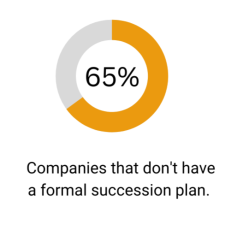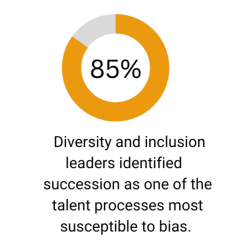Succession Planning Process
Your organization's future is at stake.
We help you secure it.
Most organizations recognize that having a succession planning process is important. However, many don’t know how to do it right or fail to make it a top priority. So, if you’re reading this, you are one step ahead of your competition! Like everything we do, we have planning for succession down to a science. We’re here to help you do it right and, do it right now.
Succession Planning Process Steps

An effective succession planning process requires a structured approach with well-defined steps. For mission-critical roles below the C-suite, we group the process activities into 4 steps.
We start by helping you to identify mission-critical roles and success factors. Then, we conduct executive assessments and 360 feedback to help you identify successors. Next, we partner with executive coaches to develop key leadership skills. Finally, we guide you on how to measure the effectiveness of the process so you can continuously improve it.
With an efficient process, well-equipped committees, and proper tools, steps 1 and 2 can be completed in 2 months. And, we can help you to do just that.
CEO Succession Planning has some additional steps and considerations. Learn more.
"The PCI assessment is a key instrument in Cadillac Fairview's talent assessment toolkit. The assessments, and time with an organizational psychologist, provide an objective data set to support all facets of our talent processes including recruitment, succession planning, and leadership development. Our CF Values are core to everything we do, and Deborah Bell and team have been incredible partners in aligning insights and reports to reinforce our Values behaviours that support our OneCF Culture and enable business performance." - Vice President, Human Resources and Change Management
- Vice President, Human Resources and Change Management
Top 4 Reasons to Prioritize Succession Planning
We’ve done the research for you. Here are some powerful statistics that build the business case for making Succession Planning a top priority.
Fail less, save more.
Whether hiring from the outside or promoting from within without proper preparation, successors are more likely to fail than succeed. In addition to the cost to replace the leader, failures cause disruption that leads to frustration, disengagement, and turnover.

Gain competitive advantage.
With the great resignation, high turnover rates, and a shortage of qualified external candidates, the future is unclear. By having a formal succession planning process, you’ll be better-positioned than two-thirds of other organizations to fill critical roles.

Build a diverse bench.
Succession planning processes that lack transparency, structure, and objectivity can create systemic bias. This serves as a barrier to diversity and the associated positive business outcomes. A contributing factor is the use of a single nominator, which is still a widespread problem today. Source

Retain top talent.
Hi-pos want to know what opportunities you’ll give them and the steps they need to take to reach their career goals. Transparency and visibility of talent review and succession planning processes will keep them engaged while preparing for future roles.


The future of your organization depends on the steps you take today. We’re here to get you started.
Overcoming Obstacles in Succession Planning
Common reasons include concerns about how to nominate successors, how to communicate the process, and how to measure outcomes. Indeed, these are 3 critical issues that need to be addressed for the initiative to be successful. Click on the tabs below to see how to solve three common Succession Planning problems. For more tips, read our Succession Planning Best Practices blog.
-
Past performance is not a good predictor of future success at the next level. And, this problem is amplified when a single nominator is used.
-
What happens if that one successor leaves or decides they don’t want the job? You are back to square one.
-
In many organizations, systemic issues result in the underrepresentation of certain groups at the executive level. Therefore, if your succession planning process only includes subjective data, this problem is perpetuated.
Solution: A Robust Succession Planning Process
The solution to this problem is to include an objective executive assessment as an input to the process. This will help you to nominate a diverse pool of potential successors that have what it takes to lead at the next level. Executive assessment allows for an apples-to-apples comparison of nominees and an objective, fair, and accurate assessment of potential. Learn more about our approach here. And, be sure to select an executive assessment partner that has validated their process against relevant outcomes.
Some people believe that succession planning should be kept top secret to avoid competitors from stealing top talent. Or, they worry that they may lose valuable leaders who aren’t nominated. However, the problem with this approach is that it can breed a culture of distrust, increase perceptions of unfairness, and encourage unhealthy competitiveness among peers.
Solution: Be Transparent
By communicating the process in an open and honest way, you will build a culture of trust. In turn, research shows that you will improve your changes of retaining top talent.
Too often, the focus is on the process and not the outcomes. This can be a stumbling block to receiving a budget for succession planning because effective executives make decisions based on data. And, if you want that budget renewed next year, you’ll need the data to support it.
Solution: Identify Metrics from the Start
By establish metrics and gathering baseline data, you’ll set your process up for success in at least two ways. First, you will be able to show how metrics changed for the better. In doing so, you have ta better chance of gaining buy-in and approval to continue the program next year. Second, when the metrics didn’t improve as you expected, you’ll be able to identify opportunities for improvements. Then, you can make the changes and measure your results.
